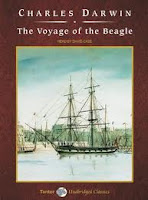Foremost: readers be warned. This book is sold in both abridged and
unabridged forms. It goes without saying
that the unabridged contains far more details and the abridged reads more like
a travelogue. The prospective buyer
should investigate this prior to purchase, depending on the expectation. This review is for the unabridged.
Certainly more well known for his The Origin of the Species and the storm
of ideological discussion that has erupted since its publishing, few are aware
that Charles Darwin, prior to setting down on paper his landmark theory of
evolution, took a five year, round-the-world trip. Signing on as biologist to the crew of the Beagle in 1831 and returning to Britain
in 1836, the journey took Darwin to the south Pacific, Australia, Africa, and
most predominantly, numerous locations in South America. Keeping a journal along the way, The Voyage of the Beagle is the record
of that journey.
Darwin
having a keen eye for detail, the pages of Voyage
are filled with descriptions of life in every form, including human during the
trip. As the ship’s biologist, Darwin was responsible
for cataloguing of the varieties of life they encountered, from Australian
marsupials to Galapagos turtles, ferns to flowers. That his journal also contains the social
events of lords and ladies his ship was greeted by at harbors around the world,
gives a true travelogue feel to the narrative, one that indicates Darwin, along
with being incredibly insightful, was not a half observer of human behavior.
And it is the descriptive elements which are the
main reason to buy the book. Readers
seeking insight into the rudiments of Darwin’s
theories will find material, but nothing stated directly. Details, details, details, the land and
animal forms the ship encounters most fully occupy Darwin’s thoughts. A real treat for nature lovers, his taxonomy
of birds, fish, mammals, and all between, not to mention the mountains he
climbs, seas he sails, and forests he walks come to life in more than Discovery
channel detail. (If
you prefer more of a travelogue experience and less of the minute details of
bird’s wings, etc., you’d do best to buy the abridged version, though not only descriptions
are elided.)
The times being what they were, readers with a sensitivity to colonialism, slavery, and the other evils of European empires in the 19 th century would perhaps do best to avoid The Voyage of the Beagle. Darwin never glorifies these forms of “civilized” malice, but he does, however, describe them, delineating it for what it is, never openly voicing any disagreement or support of the social practices his fellow Europeans around the world are participating in. Thus, be warned.
In the end, The
Voyage of the Beagle would perhaps be known only to zoologists and
biologists were its writer not Charles Darwin.
This thought, however, should do nothing to detract from the travelogue
experience his journals impart. Similar
to Capt. Cook’s logbook, with a special emphasis on flora and fauna, readers
looking for a peep at the world as it was almost 200 years ago can’t go
wrong—and may even be inspired to do a little traveling of their own in the
process. This is Natural History in more
ways than one.


I probably wouldn't be able to get through the unabridged Voyage of the Beagle. I'm having a hard enough time with The Origin of Species. But I DO appreciate that Darwin has an amazing eye for detail...and he's very meticulous in recording it.
ReplyDeleteDoes he ever!! :)
ReplyDeleteCould you recommend an unabridged edition by any chance? I have searched for so long for one to no avail. Thanks!
ReplyDeleteApologies, I didn't read the unabridged, nor am I aware where to find a copy save the normal channels of online shops. Perhaps your local library might have an old copy?
Delete